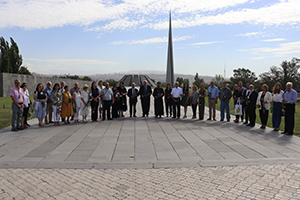17.09.2022

The three-day international conference
“Smyrna in the context of the Armenian and Greek genocides: annihilation, arson and deportation (September 1922),” organised by the “Armenian Genocide Museum-Institute” took place from September 14 to 16, 2022, (the co-organisers were: YSU Institute of Armenian Studies, RA NAS Institute of History, K. Abovyan Armenian State Pedagogical University, Haykazian University of Beirut and the Aristotle University of Thessaloniki Pontic Studies Department).
The conference was launched by an opening speech made by AGMI Director Harutyun Marutyan. He said: “Today, in the days of undisguised Azerbaijani aggression, we have convened a conference dedicated to the consequences of another - similar - act that took place a century ago. 100 years ago, thousands of innocent citizens were being killed while today, Armenian soldiers are the victims, defending the borders of the Republic of Armenia from their combat positions. Our so-called neighbour’s aggressive behaviour has not changed; they still profess the same “values” as they did 100 years ago. We must clearly realise this while building relationships.” The attendees observed a minute’s silence, at Harutyun Marutyun’s suggestion, in memory of those who died because of the aggression unleashed by Azerbaijan on September 13.
Professor Kyriakos Khatsikiriakidis of the Aristotle University of Thessaloniki’s Pontic Studies Department welcomed the attendees online: “The friendship between the Armenians and Greeks has a centuries-old history based on mutual trust. This conference proves that fact yet again”. Then he added that as in Smyrna in 1922, Turkey, the common enemy of both nations, continues its aggressive policy today.
Rt. Reverend Dr. Paul Haidostian, Rector of Haykazian University of Beirut, made a speech of welcome and noted that humanity should recognise the past not only through wealth and blessings, but also through disasters. He said that this conference would also highlight Smyrna’s literary, historical, church, political and economic life.
The conference’s opening ceremony was followed by the opening of a temporary exhibition organised by the Armenian Genocide Museum-Institute titled
“Smyrna in the context of the Armenian and Greek genocides: annihilation, arson and deportation (September 1922)” . Later the same day, the participants visited the Armenian Genocide Memorial, laid flowers near the Eternal Fire, and observed a minute’s silence in memory of the holy martyrs of the Armenian Genocide.
About forty specialists in genocide studies and related fields from Armenia, Greece, Lebanon, the Netherlands, the USA, Canada, Italy and the Czech Republic, participated in the conference.
On the first day of the conference, three sessions with the following topics were convened: “Smyrna Community Life: Literature, Writing and Publishing Culture”, “Smyrna’s Periodical Press” and “Smyrna’s Religious Life and Inter-Faith Relations”.
The first day’s main speaker was Professor Albert Kharatyan (PhD History), corresponding member of the National Academy of Sciences of the Republic of Armenia. He presented a paper titled “Smyrna’s Armenian Colony.”
Harutyun Marutyan, Director of the Armenian Genocide Museum-Institute, awarded both Albert Kharatyan and Greek researcher George Pulimenos with the “Armenian Genocide Museum-Institute” Foundation’s “Henry Morgenthau” commemorative medal for their contribution to the study of Smyrna’s Armenian community.
Three sessions were convened on the second day of the conference with the following topics: “Culture of Memory and Physiological Outlines,” “Crime, Campaign and Urban Culture” and “Cultural Identity in the Context of Extermination of Smyrna’s Armenians and Greeks: The Destruction of its Christian Heritage.”
The second day’s first speaker was famous linguist, Germanist and Armenologist, Professor Dora Sakayan of McGill University. She presented a paper titled “A document or literary work? My grandfather Dr. Karapet Hacherian’s diary about the Smyrna disaster”.
The second speaker was Verjiné Svazlyan, (PhD Philology) a leading researcher in the Republic of Armenia’s National Academy of Sciences Institute of Archeology and Ethnography. Her paper was dedicated to the Smyrna disaster and the historical memory of its people.
The keynote speaker, Hervé Georgelen, lecturer, National and Kapodistria University History Department of Modern Turkish and Asian Studies, Athens, presented a paper titled “The Conquest of Smyrna by the Kemalists (September 1922): targeting and blaming the Armenians first.”
On the second day, a ceremonial presentation of the postcard titled “History of Armenians: Smyrna” took place, with the participants later receiving copies.
Two sessions were convened
on the third day of the conference with the following topics: “Act of Salvation: Witnesses and Humanitarian Operation” and “Human Rights Violations, Legal Evaluations and Perspectives: Migration and Survivors’ Immigration to Soviet Armenia.”
The main speaker was Reverend Dr. Paul Haidostian Rector of Haykazian University of Beirut. He presented a paper titled “A forgotten Soul in the Aegean Sea: the Life and Death of Rev. Hakob Yeranian.”
After question-and-answer sessions and discussions, Edita Gzoyan, Deputy Scientific Director of the Armenian Genocide Museum-Institute summarised the results of the conference. She noted that the conference had taken place in difficult times for Armenia, during military operations unleashed by Azerbaijan in the Armenian-Azerbaijani border region, adding that Turkey, the common enemy of Armenians and Greeks, was still following its 100 yea-old anti-Armenian and anti-Greek policy. She expressed her gratitude to all who contributed to the important task of organising and staging the conference.
The participants then visited the Nubarashen settlement for the New Smyrna Street naming ceremony.
Ashot Ghadyan, deputy head of the Nubarashen administrative district and Goharik Voskanyan, chief specialist in the Department of Education, Culture and Sports, welcomed the international conference participants. Father Bartholomeos Hakobyan, spiritual pastor of Nubarashen’s Holy Martyrs Church, led a memorial service in memory of Smyrna’s innocent Armenian and Greek victims of 1922.
Goharik Voskanyan welcomed the guests and presented Nubarashen’s history, highlighting the improvements and development works carried out in the township.
Nubar Berberyan and Sargis Charpikyan (Jrtykhian), Nubarashen’s oldest residents, descendants of Armenian survivors of Smyrna, were also present at the ceremony.





